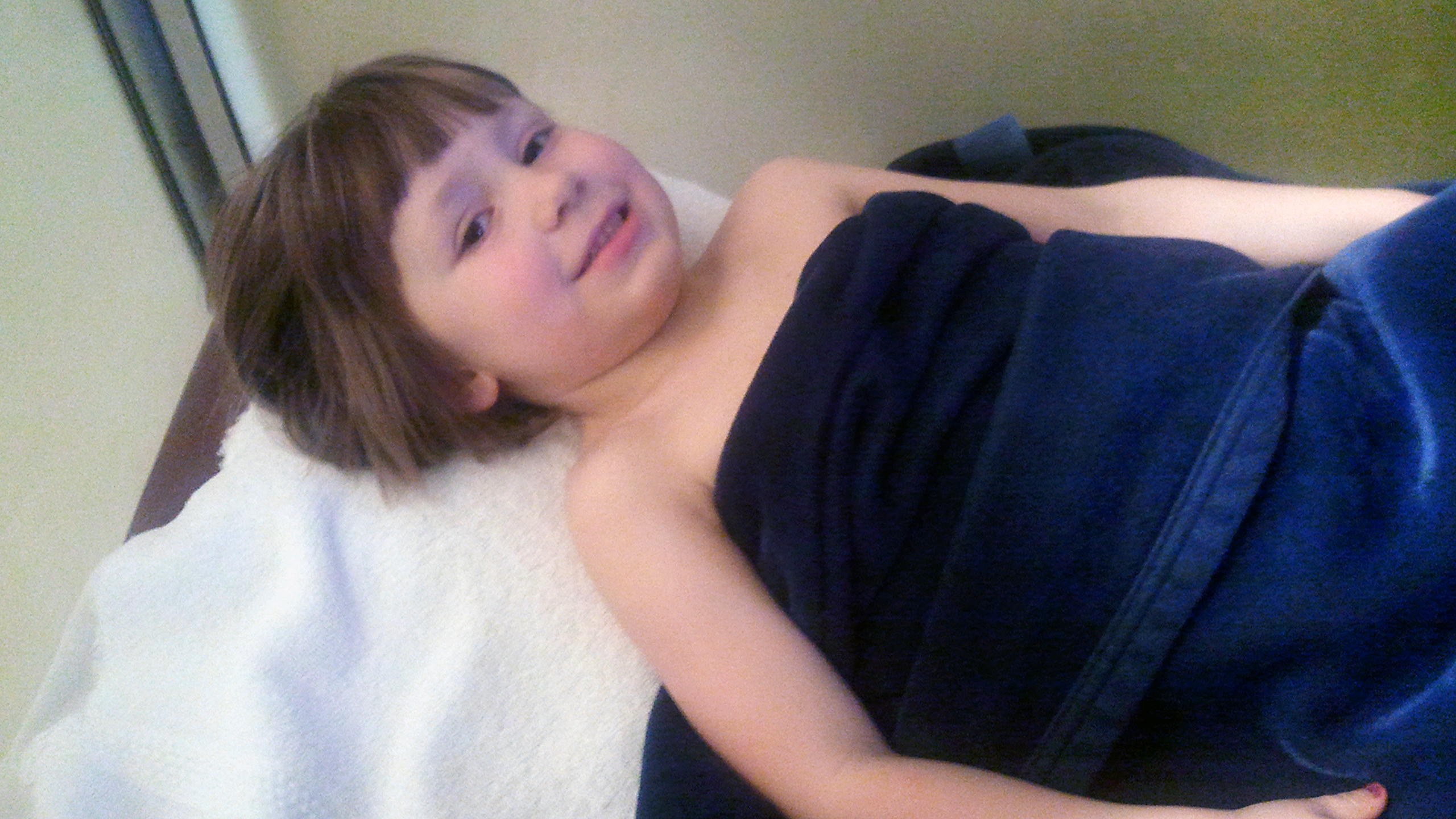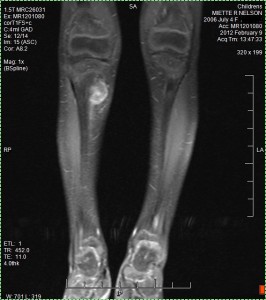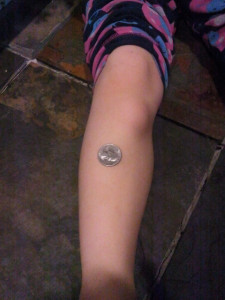So the story left off with us hightailing it out of Seattle Children’s hospital in Seattle. Miette was glad to be out of the hospital, even though we think it was all an adventure to her. Little did she realize at that time how much she would come to despise hospitals. We went back to the hotel and a little after that, Miette and Kelly went swimming. She was looking forward to it all day.
Not showing the extreme worry on your face, to your cancer stricken child, so they can continue to have fun was going to be a huge challenge from now on. We had yet to tell Miette what she had and what it meant. She still only knew that she had a bump on her leg that needed to go away. She didn’t know the severity or the impact that it has on people. As her parents, we were in crisis mode – and reminded of it every time we looked at that bump on her leg. As Miette, it was just another (but different) day and some swimming fun.
Hitting the Cancer Treatment Books (or Clinical Trial Studies)
Once we got back home, the most important project I have ever undertaken started. Cancer research. Cancer treatment research. It sounds simple. It is anything but simple. In order to understand the treatments, one must understand the cancer. In order to understand the cancer one must understand the human body. What is the cancer doing? Where did it come from? Why can’t it be stopped? Why doesn’t the immune system just fight it? What really is “chemo”? When did they start using chemo to fight cancer? Why does chemo kill cancer cells? Why is it called Ewings Sarcoma? What makes it different than other cancers?
Tons of questions. Too many to list. Biology and science; the two topics I wish I had paid more attention to in school. I believe, in schools today, teaching kids about the human body to the detail they teach math and English for the sole purpose of getting them ready to fight cancer should be high priority. The name of the class should have “cancer” in it. They will fight it, someday. Either for themselves, for their kids or their parents. At some point in everyone’s life, cancer research will happen. It should required in one’s senior year of high school so it will be as fresh as possible. Understanding the research, understanding the writings of study papers and clinical trials is so much easier with an educated background in biology. That education will be more valuable, by far, than say Trig, or the solar system or a foreign language. I took German in high school. I never used it after that, but I had to a take a foreign language class; it was a requirement for graduation. If I was required to take a class that helped me get a head start of understanding what cancer is and does, I would be much better off and equipped to handle “life”.
Initial Alternative Cancer Treatment
But back to our story. Hours of research turned into days… and then weeks. We didn’t like the unknown of what was proposed to be put in our daughter’s blood stream. Maybe we dived in backwards, but we started researching chemo agents first. I will get more into that research later. At the same time, we began searching for a naturopath that would assist us with helping Miette and begin to build our team of doctors. We were referred to a doctor in Spokane, Dr. Latitia Dick (Windrose Naturopathic Clinic). We spoke on the phone and decided to take Miette up there and do an initial evaluation. We took the first open time slot available. The person who referred us to “Dr. Tish” was a recent Bastyr University graduate so we felt it was a good lead. She is a second generation naturopath and had the education and background to support her practice. At Miette’s evaluation, Dr. Tish first went into diet/food intolerance and the changes we could make. We already were pretty organically and whole food minded so there wasn’t a lot of changes. We made a point to cut out as much fruit and sugar as we could. We also started Miette on what is called Constitutional Hydrotherapy to kick start her body’s defense mechanisms. Our primary goal, before deciding on any conventional treatment (chemo) was to build up Miette’s immune system as best we can via a regimen of herbal and vitamin supplements and the hydrotherapy. If natural treatments also made a dent in the tumor, then even better. Miette’s tumor was a slow growing tumor. We were hoping to slow it even further. The ongoing treatment plan that formulated after a couple visits to Windrose was hydrotherapy twice a week (this means two trips to Spokane each week) and the following list:
- Triton MRL
- Natrum Sulphuricum
- Natrum Murr
- Iodoral
- Thymus PMG
- Drenatrophin PMG
- Eleuthero Root
- Vitamin D 4000
- Fish Oil
- Symphytum 30c
- Comfrey poultice
Each one of these has its own benefit. Not all are attributed to directly fighting cancer. But they ALL attribute to the immune system, strengthening Miette’s body and getting her ready for the fight of her life. As you can imagine, this list, which needed to be replenished about every 30 days wasn’t free. Conventional cancer treatment is virtually “free”, as long as its a child. I say virtually because there’s still insurance deductibles, the cost of trips back and forth, lodging while staying in another town for treatment, healthy meals (organic and whole foods), etc. Natural treatments such as this list is ALL out of pocket. Alternative cancer treatment such as this is frowned upon by conventional minds. The FDA, NHI, ACS, Hospitals, etc and all insurance companies are conventionally minded to say the least. I won’t go into a rant about the money aspect of this conspiracy right now (I will do that later) but I will say giving Miette the BEST chance of overcoming this was at a huge financial cost, one of which we are still struggling to overcome; as every family who has ever battled cancer could testify. Going with conventional only would have been cheaper. But we knew that wasn’t an option whatsoever. We were going to go into debt to whatever degree it took.

Thankfully we had friends in north Spokane who let us stay with them during these twice per week treatments. It takes a village to raise a child and it takes a village to battle cancer. Thanks to them and to all those others who helped us along the way. We hope we never have to repay anyone in the same way.
We went with this treatment, starting towards the end of February and went with it until chemo treatment started at the beginning of May.
So, while this immune system build up treatment was going on, the chemotherapy research was happening at the same time. Let me tell you how disturbing that process was… well, I’ll tell you in the next post.
To be continued….




